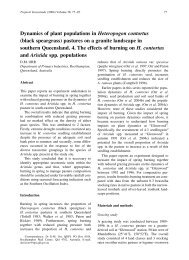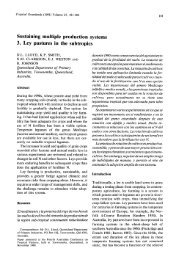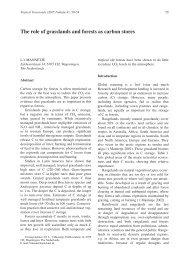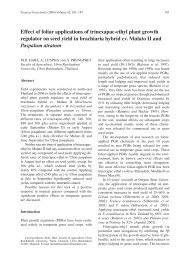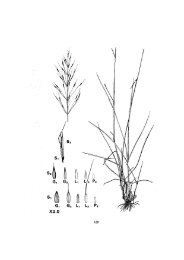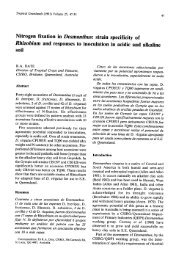Seed production of two brachiaria hybrid cultivars in - Tropical ...
Seed production of two brachiaria hybrid cultivars in - Tropical ...
Seed production of two brachiaria hybrid cultivars in - Tropical ...
You also want an ePaper? Increase the reach of your titles
YUMPU automatically turns print PDFs into web optimized ePapers that Google loves.
32 M.D. Hare, P. Tatsapong and K. Saipraset<br />
or other Brachiaria spp. (negligible seed yields)<br />
<strong>in</strong> earlier trials on the same site (Hare et al. 2005),<br />
but below seed yields <strong>of</strong> ruzi grass (313–350 kg/<br />
ha) elsewhere <strong>in</strong> Thailand (Phaikaew and Pholsen<br />
1993; Kowithayakorn and Phaikaew 1993).<br />
Both Mulato and Mulato II produced sufficient<br />
<strong>in</strong>florescences, racemes and spikelets to<br />
<strong>in</strong>dicate a potential for useful seed yields. However,<br />
by seed harvest, there was massive failure<br />
<strong>of</strong> seed-set, caryopsis maturation or both, with<br />
the cleaned seed conta<strong>in</strong><strong>in</strong>g less than 2% <strong>of</strong><br />
the spikelets formed by the crops. Weather conditions<br />
dur<strong>in</strong>g seed maturation were suitable for<br />
seed-set, with bright sunsh<strong>in</strong>e and no ra<strong>in</strong>. The<br />
subsequent failure <strong>of</strong> seed-set most probably was<br />
due to pollen sterility, if judged by a study on<br />
<strong>brachiaria</strong> <strong>hybrid</strong>s show<strong>in</strong>g that more than 65%<br />
<strong>of</strong> pollen gra<strong>in</strong>s were sterile (Risso-Pascotto et al.<br />
2005) and that this sterility was genetic.<br />
However, <strong>in</strong> further trials on clos<strong>in</strong>g date<br />
(Hare et al. 2007a) and harvest<strong>in</strong>g methods (Hare<br />
et al. 2007b), the highest seed yields <strong>of</strong> Mulato<br />
II reached 258 and 580 kg/ha, respectively, while<br />
those <strong>of</strong> Mulato rema<strong>in</strong>ed low, <strong>in</strong>dicat<strong>in</strong>g that not<br />
all <strong>brachiaria</strong> <strong>hybrid</strong>s have genetically low seed<br />
yields. The low seed yields <strong>of</strong> Mulato II <strong>in</strong> this<br />
study (Trial 4) were due to the trial site becom<strong>in</strong>g<br />
severely waterlogged <strong>in</strong> September, caus<strong>in</strong>g<br />
tiller death and a very low emergence <strong>of</strong> <strong>in</strong>florescences.<br />
In contrast, the harvest<strong>in</strong>g method trial<br />
50 m away <strong>in</strong> the same paddock was not waterlogged<br />
and the best treatment produced seed<br />
yields <strong>of</strong> 580 kg/ha (Hare et al. 2007b). Smallholder<br />
farmers have also produced Mulato II seed<br />
yields <strong>in</strong> excess <strong>of</strong> 500 kg/ha.<br />
The results emphasise the importance <strong>of</strong><br />
method <strong>of</strong> establishment for seed <strong>production</strong><br />
<strong>in</strong> these <strong>brachiaria</strong> <strong>hybrid</strong>s. In our studies, seed<br />
Table 9. Effect <strong>of</strong> method and time <strong>of</strong> plant<strong>in</strong>g <strong>of</strong> Mulato on dry matter yields <strong>in</strong> stubble at seed harvest (Trial 3).<br />
Method <strong>of</strong> plant<strong>in</strong>g<br />
Stem DM<br />
(kg/ha)<br />
Leaf DM<br />
(kg/ha)<br />
Total DM<br />
(kg/ha)<br />
<strong>Seed</strong> 5220 3381 8601<br />
Tillers 6212 3693 9905<br />
LSD (P < 0.05) 940 ns 1238<br />
Time <strong>of</strong> plant<strong>in</strong>g<br />
May 5991 3793 9 784<br />
June 6031 3563 9 594<br />
July 6420 3787 10 207<br />
August 4423 3005 7 428<br />
LSD (P < 0.05) 1329 587 1 752<br />
Table 10. Effect <strong>of</strong> time <strong>of</strong> plant<strong>in</strong>g <strong>of</strong> Mulato II on dry matter yields and crude prote<strong>in</strong> (CP) concentrations <strong>in</strong> forage cut at clos<strong>in</strong>g<br />
(August) for seed <strong>production</strong> (Trial 4).<br />
Tiller plant<strong>in</strong>g time<br />
Stem DM<br />
(kg/ha)<br />
Stem CP (%)<br />
Leaf DM<br />
(kg/ha)<br />
Leaf CP (%)<br />
Total DM<br />
(kg/ha)<br />
May 16 1433 10.2 1725 13.4 3158<br />
June 1 440 12.0 653 17.6 1093<br />
June 16 123 13.4 312 17.8 434<br />
July 1 46 15.5 165 17.2 211<br />
LSD (P < 0.05) 325 2.0 335 1.8 647<br />
Table 11. Effect <strong>of</strong> time <strong>of</strong> plant<strong>in</strong>g <strong>of</strong> Mulato II on dry matter yields <strong>in</strong> stubble at seed harvest (Trial 4).<br />
Tiller plant<strong>in</strong>g time<br />
Stem DM<br />
(kg/ha)<br />
Leaf DM<br />
(kg/ha)<br />
Total DM<br />
(kg/ha)<br />
May 16 5085 4524 9609<br />
June 1 4073 3549 7622<br />
June 16 3568 3681 7249<br />
July 1 2824 3172 5996<br />
July 15 2197 2666 4863<br />
August 1 1475 2152 3627<br />
August 16 595 1357 1952<br />
LSD (P < 0.05) 1402 750 1919



